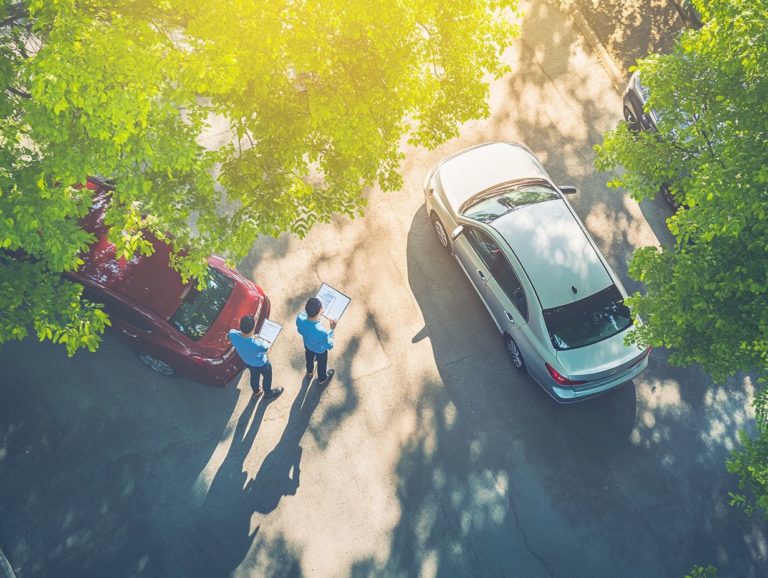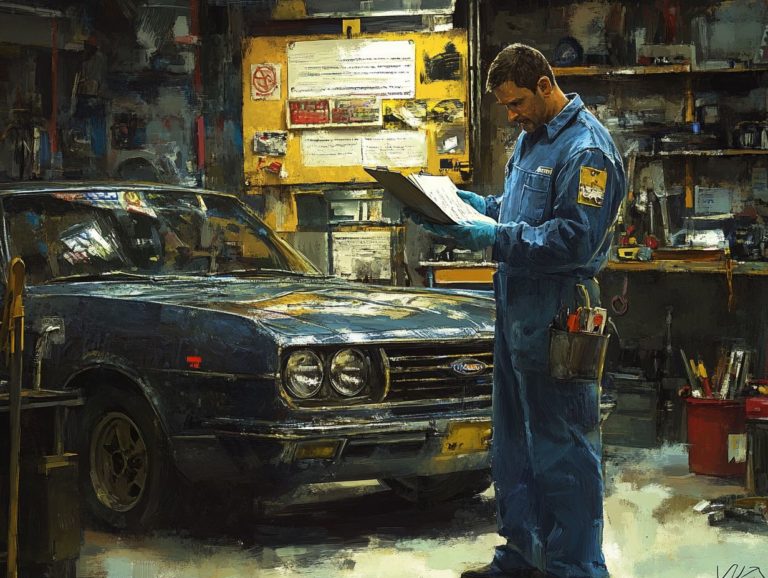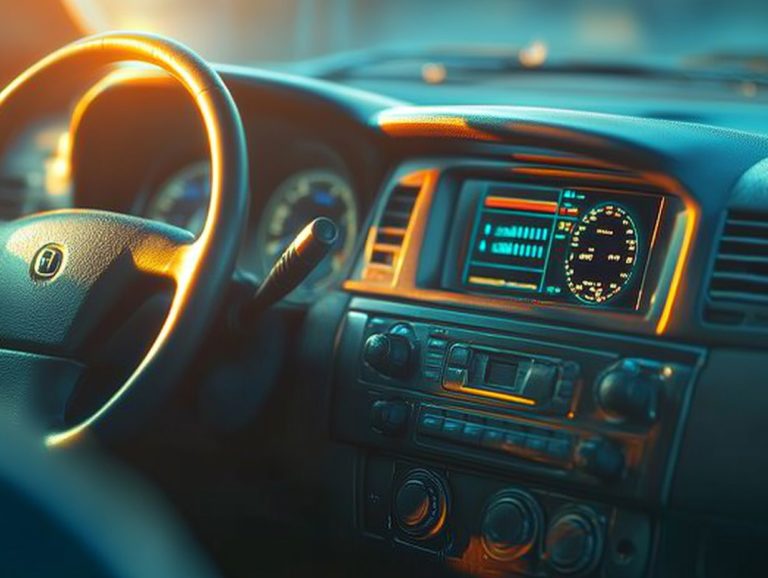Tips for Spotting Flood-Damaged Used Cars
When you re shopping for a used car, the last thing you want is to end up with one that has flood damage.
Spotting the signs of such damage is essential, as it can lead to serious mechanical issues in the future. This article will guide you through the unmistakable physical indicators and mechanical problems to watch for, along with an inspection checklist to keep you on track.
You ll also receive valuable advice on navigating the purchase of a flood-damaged vehicle.
Get ready to arm yourself with the insights necessary for making a smart investment!
Contents
Key Takeaways:

- Look for physical indicators such as musty odors, water stains, and discolored upholstery when inspecting a used car.
- Be cautious of mechanical issues like rust, corrosion, and malfunctioning electronics, which can signal flood damage.
- Thoroughly inspect the vehicle for flood damage and consider factors like the car’s history, repair costs, and potential for future issues.
What are Flood-Damaged Used Cars?
Flood-damaged used cars are vehicles that have been submerged in water often due to severe weather events like hurricanes or floods. Such immersion can wreak havoc on crucial components, including the engine, electrical systems, and even the interior.
This makes it essential for certified mechanics to conduct thorough evaluations. These vehicles often come with a salvage title, which indicates that the car was declared a total loss by the insurance company.
For buyers, this makes it imperative to investigate the vehicle’s flood history, utilizing resources like the NMVTIS system. Being informed is not just wise; it s essential for ensuring your safety and making a sound purchase.
Signs of Flood Damage
Recognizing the signs of flood damage in a used car is crucial for steering clear of potential mechanical problems and long-term corrosion issues. These factors can greatly diminish the vehicle’s reliability and safety on the road.
Look out for common indicators like visible water stains, mildew, and musty odors. Each of these can signal serious underlying issues that might not reveal themselves right away to an unsuspecting buyer.
Physical Indicators
When assessing a used vehicle, it’s crucial to identify physical indicators of flood damage, as these signs can reveal the extent of potential water exposure. Keep an eye out for telltale signs like water stains on the upholstery, rust inside the vehicle, or that musty mildew smell these can all point to past flooding and signal possible mechanical issues lurking beneath the surface.
It’s vital to check electrical components for corrosion, as water can wreak havoc on wiring and fuses, causing headaches down the road. Don’t overlook the engine compartment and undercarriage; inspecting for unusual grime or residue is essential, since floodwater often carries debris and contaminants that can be tricky to clean.
The importance of a thorough vehicle assessment cannot be overstated. Recognizing these indicators can significantly reduce the risks associated with purchasing a car that may have been compromised by flood damage. A comprehensive inspection enables you to uncover hidden issues that could lead to costly repairs in the future.
Mechanical Issues

Mechanical issues arising from flood damage can pose significant risks to your vehicle’s safety and performance. Water intrusion can compromise critical systems, affecting everything from electrical components to battery performance.
If you notice signs of mechanical problems like difficulty starting the engine or unusual noises it may signal underlying corrosion issues that warrant a visit to a certified mechanic.
The repercussions of such damage can be extensive, leading to costly repairs if not addressed promptly. As a buyer, it s crucial to be vigilant; hidden consequences may not reveal themselves at first glance. Problems like compromised fuel systems or brake failures can significantly impact drivability and safety.
A thorough inspection by a professional can uncover battery damage and other hidden issues, ensuring you grasp the long-term implications of your investment. Staying aware of these factors is essential for making informed decisions and maintaining your vehicle’s safety.
Take your time when inspecting used cars before making a purchase. Your diligence can save you from significant headaches down the road!
How to Check for Flood Damage
Before purchasing a used car, checking for flood damage is essential for your safety and financial security.
A comprehensive inspection checklist is a vital resource in this process.
Also, use vehicle history reports and the NMVTIS system to reveal any flood-related incidents.
Inspect the vehicle thoroughly, focusing on both the interior and mechanical components.
This proactive approach helps you make informed decisions and safeguard your investment.
Inspection Checklist
An effective inspection checklist for flood damage should cover a range of items to assess potential mechanical problems or hidden damage.
Check these key components:
- Engine compartment
- Electrical systems
- Interior for signs of water exposure or mildew
These checks provide critical insights into the vehicle’s flood history.
Your checklist should include:
- Inspecting the undercarriage for rust or corrosion
- Checking upholstery and carpets for water stains or odors
- Evaluating fluid levels for signs of contamination
Don t overlook the tires; submerged vehicles may have damage that compromises safety.
It’s crucial to have certified mechanics perform these inspections, as their expertise uncovers issues that may go unnoticed.
Addressing these factors secures your safety and helps maintain the vehicle’s resale value.
Buying a Flood-Damaged Used Car
When thinking about buying a flood-damaged used car, approach this decision with a discerning eye and awareness of various factors.
Consider the vehicle’s salvage title status and potential implications from insurance companies.
Engage in research and gather valuable buyer tips to navigate the complexities of vehicles with a flood history.
This diligence helps you avoid warranty issues and resale hurdles.
Things to Consider Before Purchasing

Before purchasing a flood-damaged used car, weigh several critical factors that could influence your investment.
Dive into the vehicle’s history, assess hidden damage, and understand title transfer nuances, all of which impact future resale value.
Review vehicle history reports to shed light on past flooding incidents.
Utilizing buyer tips helps you spot signs of water exposure or hidden issues.
Understanding a salvage title is crucial; it can significantly affect your insurance premiums and loan eligibility.
Ask sellers for transparency regarding repairs or modifications made after the flooding.
A meticulous inspection of the vehicle, preferably with a trusted mechanic, reveals underlying problems that may not be immediately apparent.
Evaluate warranty options, especially for components that may have suffered due to water exposure.
By paying attention to these factors, you can make informed decisions that protect your investment and safety.
Preventing Flood Damage in Your Own Vehicle
Preventing flood damage requires a proactive approach and consistent maintenance, especially in flood-prone areas.
Consider flood insurance as an additional layer of protection for your investment.
Stay vigilant about potential risks and take precautions to guard your vehicle against water exposure.
Stay proactive and protect your investment today!
Tips for Avoiding Flood Damage
To prevent flood damage, embrace proactive strategies. Regular vehicle maintenance and understanding the advantages of flood insurance are crucial, especially if you live in flood-prone areas.
Consult a mobility dealer for insights on vehicle models that are less vulnerable to flooding. Routine maintenance checks are essential. Inspect seals, check brake systems, and ensure proper drainage to significantly reduce risks associated with heavy rainfall.
When severe weather approaches, store your vehicle in elevated areas or garages to protect it from rising waters. Investing in flood insurance provides financial protection and peace of mind, knowing you have measures in place to recover if the worst happens.
These proactive approaches greatly enhance your vehicle’s resilience in vulnerable regions.
Frequently Asked Questions
What are some tips for spotting flood-damaged used cars?

- Check for signs of water damage, such as a musty smell, rust, or water stains on the car’s interior or exterior.
- Look for fogging or condensation inside the headlights, taillights, or other light fixtures.
- Examine upholstery and carpets for any signs of mold or mildew.
- Inspect car parts for signs of water damage, such as rust or corrosion.
- Look for mismatched paint or uneven gaps in body panels, which could indicate repainting to hide flood damage.
- Get a vehicle history report to check if the car has been in a flood or has a salvage title.
Why is it important to spot flood-damaged used cars?
Spotting flood-damaged cars is crucial because they can have serious mechanical and safety issues that endanger you and your passengers. They are often more prone to breakdowns and expensive repairs.
How can I check if a car has a salvage title?
To check if a car has a salvage title, request a vehicle history report or use a free online VIN check service. The title should indicate if the car has a salvage or rebuilt status.
Can flood damage be repaired?
In some cases, flood damage can be repaired, but it depends on the damage’s extent. Always have a professional mechanic thoroughly inspect the car before purchasing to assess its repairability.
Are flood-damaged cars worth buying?
Generally, it is not recommended to buy a flood-damaged car due to potential hidden issues. Investing in a used car with a clean history is better to avoid safety and financial risks.
What should I do if I suspect a car has flood damage?
If you suspect a car has flood damage, walk away from the purchase. You can report the car to the National Insurance Crime Bureau’s VINCheck to see if it has been reported as stolen or salvaged due to flood damage.






